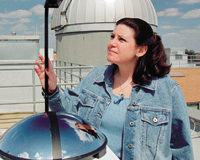![]()

“Answers in the Sky and the Classroom”
Michele McCourt, atmospheric physics Ph.D. student, looks to the sky to understand the physics of carbon monoxide produced on earth. McCourt is a GEST (Goddard Earth Sciences and Technology) fellow in atmospheric physics at UMBC.
For her dissertation, McCourt studies the effects of biomass burning in southern Africa on the earths troposphere. Fires burning to clear fields for cropland in the southern hemisphere produce roughly as much troposphere carbon monoxide as cars and industrial parks do in the northern hemisphere, she says. McCourt analyzes data collected from the international Southern Africa Regional Science Initiative (SAFARI 2000) to examine the correlation between carbon monoxide and biomass burning to better understand how these small scale but widespread fires affect the overall global climate.
McCourt first became interested in physics during a basic physics class she took as an undergraduate at Lenoir-Rhyne College in Hickory, N.C. At the time, I wanted to be a high school math teacher, says McCourt. I enrolled in the required physics class for non-majors, and my professor encouraged me to take the calculus-based physics class instead. I just kept taking more classes. In the end, she graduated with a double major in mathematics and physics.
Today, McCourt asks, How can you not be interested in physics? Its something everyone uses every day of their lives. Her goal is to continue her research on the environment and in the process make her findings and subject matter more accessible.
After I graduate I would like to obtain a faculty position at a university. I want to teach the basic physics classes for non-physics majors. There are a lot of students who are frustrated by physics. There is so much that can be done to encourage more students, especially women, to study physics, McCourt says. At UMBC, the physics department makes a conscious effort to recruit women into the program. The national average for women students in graduate physics programs is 10 percent; at UMBC it is roughly 25 percent.
Her first year at UMBC, she was a teaching assistant for her advisor W. Wallace McMillan, assistant professor of physics and an affiliate JCET professor. He taught the basic physics lecture for non-majors with over 70 students in the class. Not only did he know their names, but also how each of them was doing in the course. He made physics fun. Thats the kind of teacher I want to be, says McCourt.
